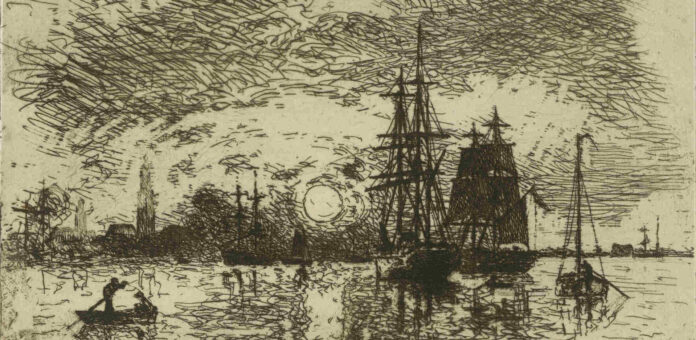Does everyone really know what Impressionism is? It is in this context that the exhibition comes into play, presenting rarely shown works by famous artists as well as new discoveries by as yet unknown ones.
It is atmospheric moods that this different Impressionism – beyond painting – brings to paper in new or rediscovered printing techniques. Artists depict impressions of shadows, steam and smog, mist and rain, night and electric light. They experiment with the proto-photographic technique of cliché-verre and use the sun to expose their hand-drawn glass-plate negatives. In the abstract black and white of etching, they draw vibrating lines to capture fleeting reflections of light on a moving water surface. The portrayal of shadows, of immateriality, entices lithographers, in particular, to create picturesque and mysterious impressions.
1881: The First Exhibition of Modern Prints in Berlin Museums
Printed or exposed – imprimé or impressionné: The new prints paved the way into the museum for Impressionism. They had the magic and dynamism of drawings by hand and were thus regarded as the epitome of artistic individuality. In 1881, this international modernism was introduced into Berlin’s museums with an exhibition of “painter-etchings by French and English artists of the modern era”, which presented an incredible 740 prints.
This represented a revolution in the way art was viewed, a coup, because at the time Impressionist art was by no means considered museum-worthy. This exhibition led the public to become fascinated with modernism, provided a fresh international impetus for contemporary artists in Germany, and launched a new collecting focus on modern prints at the Berlin Kupferstichkabinett (Museum of Prints and Drawings).
Artists Represented in the Exhibition
The Berlin Kupferstichkabinett presents its selection of this different Impressionism and the resulting innovations for the visual arts with works by, among others, Camille Corot, Charles-François Daubigny, Édouard Manet, Edgar Degas, Mary Cassatt, Berthe Morisot, Camille Pissarro, Alfred Sisley, Auguste Renoir, Paul Signac, Eugène Carrière, Joseph Pennell, James McNeill Whistler, Charles Storm van’s Gravesande, Anna Duensing, Lesser Ury, Lovis Corinth, Max Liebermann and Max Slevogt.
Several etching by Rembrandt from the 17th century and pictorialist photographs supplement this assortment and broaden the spectrum. These works provided decisive impulses for for a different Impressionism.
Exhibition Catalogue
The exhibition is accompanied by a catalogue (208 pages, richly illustrated, ISBN 978-3-7319-1433-4, €29,95).
Curator
The exhibition is curated by Anna Marie Pfäfflin, curator for 19th-century art at the Kupferstichkabinett.
Media partner: tipBerlin
A special exhibition of the Kupferstichkabinett – Staatliche Museen zu Berlin
Source : Museen zu Berlin
















